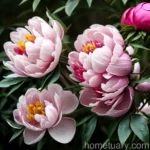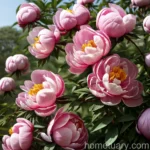Plant Scientist’s Guide to Tree Peony (Paeonia delavayi var. lutea)
As a plant scientist, I am thrilled to share my expertise and insights on one of the most majestic and captivating flowering plants – the tree peony (Paeonia delavayi var. lutea). This guide will delve into the essential aspects of tree peony cultivation, care, and maintenance, providing invaluable information for both seasoned horticulturists and enthusiastic beginners.
What is a Tree Peony (Paeonia delavayi var. lutea)?
The tree peony, scientifically known as Paeonia delavayi var. lutea, is a deciduous woody shrub that belongs to the Paeoniaceae family. Unlike herbaceous peonies, tree peonies are characterized by their woody stems and large, showy flowers. Paeonia delavayi var. lutea is a particular variety of tree peony renowned for its striking yellow flowers and elegant presence in gardens and landscapes.
Key Takeaways – Tree Peony (Paeonia delavayi var. lutea)
Before diving deeper into the world of tree peonies, here are the key takeaways that we’ll explore in detail throughout this comprehensive guide:
- Tree peony care and maintenance
- Characteristics of Paeonia delavayi var. lutea
- Cultivation and planting tips for tree peonies
- Sunlight, soil, and water requirements
- Pruning techniques for optimal growth and flowering
- Common diseases and pest control
- Propagation methods for expanding your tree peony collection
- Container gardening with tree peonies
- Landscaping and design ideas incorporating tree peonies
- Fun facts and botanist’s tips for enthusiasts
- Links to external resources for further exploration
Now, let’s embark on an enlightening journey to unravel the enchanting world of tree peonies.
Culture
Cultivating tree peonies, particularly the Paeonia delavayi var. lutea variety, demands a nuanced understanding of their growth habits, environmental preferences, and cultural requirements.
Uses
Tree peonies, including the captivating Paeonia delavayi var. lutea, serve various aesthetic and functional purposes in horticulture and landscaping. Their primary uses include:
- Ornamental beauty in gardens, parks, and landscapes
- Cut flowers for floral arrangements and bouquets
- Medicinal and herbal uses in traditional medicine
- Breeding and hybridization to develop new cultivars and varieties
Water
Adequate watering is critical for the health and vigor of tree peonies, ensuring optimal growth and abundant flowering. Proper watering practices for Paeonia delavayi var. lutea and other tree peony varieties encompass the following considerations:
- Deep watering to promote strong root development
- Consistent moisture without waterlogged conditions
- Adjusting watering frequency based on seasonal needs
- Mulching to retain soil moisture and regulate temperature
Sunlight
Tree peonies, including Paeonia delavayi var. lutea, thrive in locations with ample sunlight, although they also exhibit some degree of shade tolerance. Key aspects of sunlight requirements for tree peonies include:
- Providing at least 6 hours of direct sunlight per day
- Partial shade in hot climates to prevent scorching
- Morning sunlight for drying dew and preventing fungal diseases
- Monitoring light exposure for optimal flowering and plant health
Fertilizer
Appropriate fertilization plays a vital role in sustaining the growth, flowering, and overall vitality of tree peonies. When tending to Paeonia delavayi var. lutea and other tree peony varieties, consider the following fertilizer practices:
- Balanced, slow-release fertilizers for steady nutrient uptake
- Application timing during the early spring and post-flowering period
- Avoiding excessive nitrogen to prevent excessive foliage at the expense of flowers
- Organic amendments to enhance soil fertility and structure
Soil
Understanding the soil preferences and requirements of tree peonies, particularly Paeonia delavayi var. lutea, is crucial for establishing thriving plants and bountiful blooms. Consider the following soil-related aspects:
- Well-draining, loamy soil with good aeration
- Neutral to slightly alkaline soil pH for optimal nutrient availability
- Amending heavy clay soils with organic matter for improved drainage
- Avoiding waterlogged or excessively dry soil conditions
Pruning
Pruning is an essential aspect of tree peony care, influencing their growth habits, flowering performance, and overall appearance. Effective pruning techniques for Paeonia delavayi var. lutea and other tree peony varieties include:
- Removal of dead, diseased, or damaged wood
- Thinning out crowded branches to improve air circulation
- Trimming to shape and control the size of the plant
- Pruning immediately after flowering to encourage next season’s blooms
Propagation
Expanding your collection of tree peonies, including the delightful Paeonia delavayi var. lutea, can be achieved through several effective propagation methods:
- Division of mature plants during the dormant season
- Root cuttings to produce genetically identical clones
- Grafting to combine the desirable traits of different tree peony varieties
- Seed propagation for developing new cultivars and hybridization projects
Container Cultivation
Growing tree peonies in containers presents a compelling option for enthusiasts with limited garden space or those seeking to showcase these majestic plants on patios, balconies, or courtyards. Key considerations for container cultivation of Paeonia delavayi var. lutea and other tree peonies include:
- Selecting large, sturdy containers with sufficient drainage
- Using high-quality potting mix with good nutrient retention
- Regular watering and monitoring of moisture levels
- Providing adequate sunlight and suitable microclimatic conditions
Popularity
The allure of tree peonies, including the captivating Paeonia delavayi var. lutea, has solidified their popularity among discerning gardeners, horticulturists, and landscape designers. Their appeal lies in:
- Spectacular, large flowers in a diverse array of colors and forms
- Longevity and endurance, with plants living for several decades
- Cultural significance and symbolism in various traditions
- Versatile landscaping potential in diverse garden styles and themes
Common Diseases
Tree peonies, although relatively resilient, are susceptible to certain diseases that can undermine their vitality and flowering prowess. Familiarize yourself with common diseases affecting tree peonies, including Paeonia delavayi var. lutea, and their effective management strategies:
- Botrytis blight (Gray Mold): Prevent with proper ventilation and spacing, remove infected plant material, and use fungicidal treatments if necessary.
- Phytophthora Root Rot: Ensure well-draining soil, avoid waterlogging, and apply fungicidal drenches if symptoms are observed.
- Powdery Mildew: Maintain good air circulation, avoid overhead watering, and use fungicidal sprays to control outbreaks.
Disease Diagnosis
Accurate and timely diagnosis of diseases affecting tree peonies, such as Paeonia delavayi var. lutea, is essential for implementing effective control measures. Look out for the following symptoms and consult with plant health specialists or extension services for professional guidance:
- Fungal growth or spores on leaves, stems, or flowers
- Leaf discoloration, wilting, or abnormal browning
- Yellowing or premature dropping of foliage
- Stunted growth, reduced flowering, or overall decline in plant vigor
Common Pests
While tree peonies are relatively resistant to pest infestations, vigilance is crucial for promptly addressing any potential pest issues. Keep an eye out for the following common pests that may affect Paeonia delavayi var. lutea and other tree peony varieties:
- Spider Mites: Look for webbing and stippling on the leaves, control with predatory mites or insecticidal soaps.
- Scale Insects: Monitor for the presence of scales on stems and leaves, employ horticultural oils or systemic insecticides if needed.
- Aphids: Check for honeydew, distorted growth, and the presence of aphids, control using natural predators or insecticidal sprays.
Botanist’s Tips
Drawing from my expertise as a plant scientist, here are some valuable tips to enhance your success with tree peonies, particularly the exquisite Paeonia delavayi var. lutea:
- Observe and understand the natural growth habits and habitat preferences of tree peonies in their native range for insights into their cultural requirements.
- Implement a proactive approach to pest and disease management by maintaining good plant hygiene, monitoring for early signs of infestations, and employing integrated pest management strategies.
- Experiment with companion planting to create visually appealing and ecologically beneficial plant combinations that complement the beauty and appeal of tree peonies.
- Embrace the seasonal rhythm of tree peonies, from the emergence of spring shoots to the stunning floral displays of summer and the elegant dormancy of winter, appreciating each stage of their life cycle.
Fun Facts
Delight in these captivating and intriguing fun facts about Paeonia delavayi var. lutea and the enchanting world of tree peonies:
- The tree peony holds significant cultural and historical symbolism in various traditions, representing prosperity, honor, and beauty.
- Some tree peony cultivars, including Paeonia delavayi var. lutea, emit a delightful fragrance, adding an olfactory dimension to their allure.
- In traditional Chinese medicine, certain parts of tree peonies are utilized for their medicinal properties, ranging from pain relief to emotional well-being.
- Tree peonies exhibit remarkable longevity, with established plants living for several decades and evolving into stunning, multi-stemmed specimens.
Links to External Resources
For further exploration and in-depth knowledge acquisition on tree peonies, Paeonia delavayi var. lutea, and related horticultural topics, I highly recommend delving into the following external resources:
- American Peony Society: https://www.americanpeonysociety.org/
- Royal Horticultural Society: https://www.rhs.org.uk/
- Missouri Botanical Garden: https://www.missouribotanicalgarden.org/
- Planting Fields Arboretum: https://plantingfields.org/
In conclusion, the captivating world of tree peonies, epitomized by the remarkable Paeonia delavayi var. lutea, offers an enchanting tapestry of beauty, cultural significance, and horticultural intrigue. By embracing the insights and recommendations outlined in this comprehensive guide, you are poised to embark on a fulfilling journey of nurturing, cultivating, and reveling in the timeless allure of tree peonies.
Remember to immerse yourself in the seasonal wonders of these majestic plants, observe their botanical poetry unfold with each passing season, and relish the timeless elegance they bring to gardens, landscapes, and the human spirit.
Keywords: Tree peony care, Paeonia delavayi var. lutea, Tree peony varieties, How to grow tree peonies, Tree peony pruning, Tree peony diseases, Tree peony propagation, Paeonia delavayi var. lutea cultivation, Tree peony flowering, Tree peony planting tips, Tree peony sunlight requirements, Paeonia delavayi var. lutea characteristics, Tree peony maintenance, Tree peony soil conditions, Tree peony landscaping ideas, Tree peony fertilizing, Paeonia delavayi var. lutea species, Tree peony winter care, Tree peony pests and control, Tree peony seedlings, Tree peony garden design, Tree peony hardiness zones, Tree peony watering needs, Tree peony companion plants, Paeonia delavayi var. lutea growth habits, Tree peony blooming season, Tree peony buying guide, Tree peony container gardening, Tree peony transplanting, Tree peony landscape maintenance, Paeonia delavayi var. lutea plant family, Tree peony medicinal uses, Tree peony pruning techniques, Paeonia delavayi var. lutea propagation methods, Tree peony fertilizing schedule, Tree peony soil amendment, Tree peony winter protection, Paeonia delavayi var. lutea native habitat, Tree peony shade tolerance, Tree peony stem support, Tree peony watering schedule, Paeonia delavayi var. lutea flowering tips, Tree peony petal colors, Tree peony fragrance, Tree peony disease prevention, Tree peony insect pollinators, Paeonia delavayi var. lutea leaf structure, Tree peony hybridization, Tree peony garden maintenance, Tree peony height and spread















